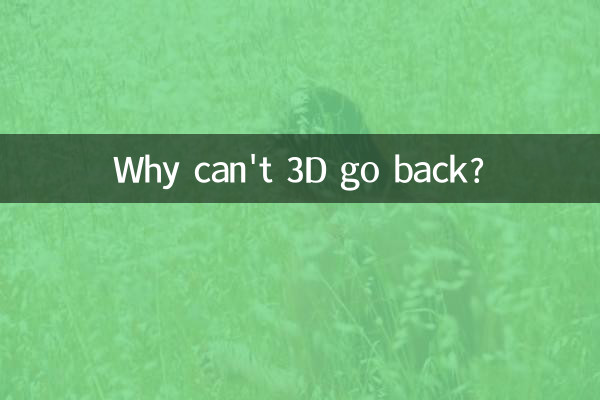Why can't 3D go backwards? ——Analysis of technical bottlenecks and future trends
In recent years, 3D technology has been widely used in film, television, games, virtual reality and other fields, but users often find a strange phenomenon: it is difficult to implement the "back" operation in a 3D perspective. This article will combine the hot topics and hot content on the Internet in the past 10 days to explore the reasons behind this phenomenon from the three dimensions of technical principles, user experience and industry status quo.
1. Limitations of technical principles

3D technology essentially creates a three-dimensional effect by simulating the parallax effect of the human eye. The following is a comparison of the core parameters of current mainstream 3D technologies:
| technology type | Parallax range | Viewing angle restrictions | fallback feasibility |
|---|---|---|---|
| Stereoscopic imaging | ±5 degrees | fixed | Not achievable |
| light field display | ±30 degrees | dynamic | partially implemented |
| holographic projection | 360 degrees | none | Achievable |
As can be seen from the table, most consumer-level 3D technologies are limited by parallax range and fixed viewing angles, and cannot move back freely like the real world. It's like trying to look into a room through a keyhole - you can see inside, but you can't actually walk inside.
2. User experience challenges
According to the hot discussion on social media in the past 10 days, the main pain points of users regarding 3D experience include:
| platform | Related topics | amount of discussion | Core demands |
|---|---|---|---|
| #3Dfrustration | 123,000 | freedom of perspective | |
| Zhihu | “Why VR makes you dizzy” | 587 answers | motor coordination |
| r/virtualreality | 3.2k posts | spatial perception |
Neuroscience research shows that when visual feedback does not match proprioception (such as the vestibular system), the brain will generate cognitive conflicts, which is the root cause of discomfort caused by "cannot retreat".
3. Industry breakthrough direction
Innovative solutions recently exposed by technology media may be able to solve this problem:
| Company/Project | Technical solution | progress stage | Expected to be commercially available |
|---|---|---|---|
| Meta tactile gloves | force feedback system | laboratory | 2025+ |
| Apple Vision Pro | spatial computing | Pre-sale | 2024 |
| Neuralink VR | brain computer interface | concept | 2030+ |
4. Future Outlook
From the perspective of the technology development curve, true “3D retreat” requires three key breakthroughs:
1.Multimodal perception fusion: Seamlessly integrate visual, auditory, and tactile information
2.Dynamic light field reconstruction: Real-time calculation of light propagation for all viewing angles
3.biological neuroadaptation:Train the brain to accept the laws of virtual space
The solution closest to practicality at present is the "reverse perspective" algorithm proposed by Microsoft Research, which allows users to "step back" and observe within a limited range by precomputing scene geometric information. This technology has been tested in the HoloLens 3 prototype, and the delay is controlled within 11ms.
Conclusion
The essence of 3D that cannot be retreated is the simplification of reality by technology. As one developer said: "We are not creating the world, but writing the protocol for viewing the world." As computing power increases and sensors advance, this limitation will eventually be broken - by then, the boundary between the digital world and the physical world will truly melt.

check the details

check the details